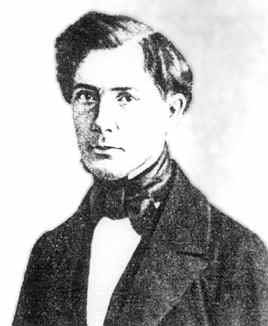


 تاريخ الرياضيات
تاريخ الرياضيات
 الرياضيات في الحضارات المختلفة
الرياضيات في الحضارات المختلفة 
 الرياضيات المتقطعة
الرياضيات المتقطعة
 الجبر
الجبر
 الهندسة
الهندسة 
 المعادلات التفاضلية و التكاملية
المعادلات التفاضلية و التكاملية 
 التحليل
التحليل
 علماء الرياضيات
علماء الرياضيات |
Read More
Date: 12-11-2016
Date: 13-11-2016
Date: 13-11-2016
|
Died: 9 September 1883 in Frontenay, Jura, France

Victor Puiseux's family moved to Lorraine when he was only three years old and he was brought up in that region of France. He attended the Collège de Pont-à-Mousson then, in 1834, he entered the Collège Rollin in Paris where he attended lecture courses by Charles Sturm.
Victor received prizes in physics in 1836 then a mathematics prize in 1837, the year he graduated and entered École Normale Supérieure. Here he became friends with Briot and Bouquet and, in 1840, he was placed first in his final examination. The following year he was awarded his doctorate for a thesis on astronomy and mechanics in which he studied planetary orbits. His thesis is a competent piece of work without showing much in the way of originality.
From 1841 until 1844 Puiseux was professor of mathematics at the Collège Royal in Rennes then, until 1849, he was professor of mathematics in the Faculty of Science in Besançon. During this period he published a series of papers in Liouville's Journal. He wrote on geometry, where he discovered new properties of evolutes and involutes and mechanics where he studied the conical pendulum, the tautochrone and similar topics.
After this Puiseux held a number of posts. He worked at the École Normale Supérieure during the years 1849 to 1855 and again between 1862 and 1868. From 1855 to 1859 he worked at the Paris Observatory. In 1857 he was appointed professor of mathematical astronomy at the Faculty of Science, after teaching courses for Le Verrier, where he succeeded to Cauchy's position. From 1868 to 1872 Puiseux held a post at the Bureau de Longitudes.
Puiseux had attended courses by Cauchy early in his career and he soon became interested in research in topics Cauchy was studying. He further developed Cauchy's work on functions of a complex variable, being the first to distinguish poles, essential points and branch points. He examined series expansions and looked at series with fractional powers. Although his work in this area was exceptionally good it became rather redundant after Riemann introduced the concept of a Riemann surface.
Laplace's theory of the Moon, presented in 1787, had been shown to be inadequate by Adams in 1853. Puiseux contributed to the problem of the acceleration of the mean motion of the Moon and his work was used by Hill in his more precise understanding of the lunar motion in 1877. Victor's son, Pierre Piseaux (1855 - 1928) also studied the motion of the moon. He went on to become professor af astronomy at the University of Paris.
Puiseux also worked on elliptic functions and studied computational methods which were used to reduce astronomical data. He was elected to the mathematics section of the Academy of Sciences in 1871 where he succeeded Lamé. Bertrand says of his election [2]:-
The election was due to his merit, but its unanimity, to his character.
Puiseux was a keen mountaineer and was the first to scale an Alpine peak which is now named after him. As a last wish he requested that no discourse should be held over his body. His profound faith helped him to bear with resignation the death of a devoted wife and of four grown children.
1. R Taton, Biography in Dictionary of Scientific Biography (New York 1970-1990).
http://www.encyclopedia.com/doc/1G2-2830903536.html
Articles:
2. J Bertrand, Victor Puiseux, Éloges académiques (Paris, 1890), 275-285.



|
|
|
|
للعاملين في الليل.. حيلة صحية تجنبكم خطر هذا النوع من العمل
|
|
|
|
|
|
|
"ناسا" تحتفي برائد الفضاء السوفياتي يوري غاغارين
|
|
|
|
|
|
|
ملاكات العتبة العباسية المقدسة تُنهي أعمال غسل حرم مرقد أبي الفضل العباس (عليه السلام) وفرشه
|
|
|